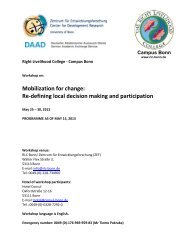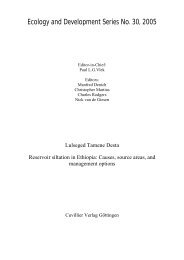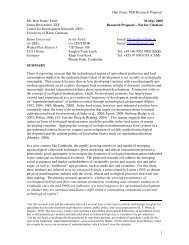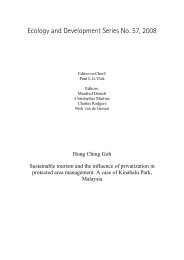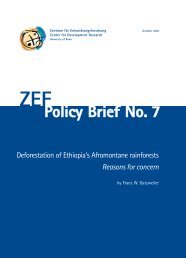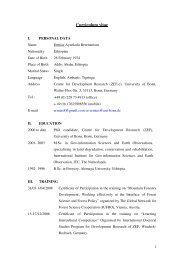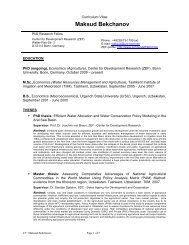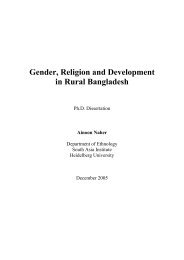ZEF Bonn
ZEF Bonn
ZEF Bonn
Create successful ePaper yourself
Turn your PDF publications into a flip-book with our unique Google optimized e-Paper software.
document and analyse the incidence of such disasters in a disaggregated fashion in<br />
order to alert policy-makers regarding regional vulnerability shifts due to long-term<br />
trends such as desertification or global climate change.<br />
Land degradation is not a sudden event but a gradual process. The costs of preventing<br />
land degradation are not high if action is taken early. Once severe, however,<br />
and reclamation becomes economically prohibitive, the land must be abandoned.<br />
Currently, a consistent loss in biological productivity is the general criterion employed<br />
to distinguish degraded from non-degraded lands, and the degree of this loss<br />
distinguishes among degradation classes. It is more of a confirmatory criterion for<br />
degradation that has already occurred, since it cannot predict whether the land has<br />
an inherent tendency to degrade. Late diagnosis adds to the cost of reclamation and<br />
can make land practically irrecoverable, causing sustained environmental damage<br />
and reducing the capacity to cope with disastrous events such as storms, floods or<br />
landslides.<br />
There is an urgent need to develop indicators that can predict the onset of desertification.<br />
Rubio and Bochet (1998) have given a list of selection and evaluation criteria<br />
that may be employed to develop an assessment system of land degradation/desertification<br />
by means of indicators.<br />
Solving or mitigating of land degradation will also require people's participation.<br />
Blackburn and Holland (1998) define people participation as the full involvement of<br />
local populations in the identification of problems and the seeking of solutions with<br />
teams of scientists, planners, and development specialists. Participation gives local<br />
people a chance to have a say in what takes place in their area in the name of<br />
development (Rhoades, 1999). It considers people's aspirations and needs as an<br />
integral part of the development agenda, which makes solutions 'demand-driven'<br />
(Rhoades and Booth, 1982). This more general lesson is of central importance in<br />
preventing long-term resource degradation and thus also the risks of exposure to<br />
natural disasters.<br />
Small holder vegetable production and<br />
irrigation, Limpopo, South Africa<br />
Essay<br />
The involvement of local populations<br />
in identifying problems<br />
and seeking solutions with<br />
specialists is crucial to preventing<br />
long-term resource degradation<br />
and risks of exposure to<br />
natural disasters.<br />
23



